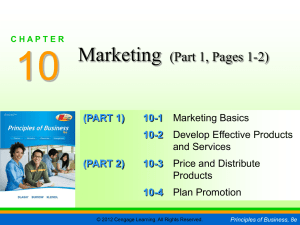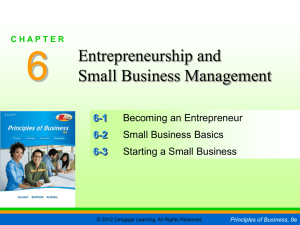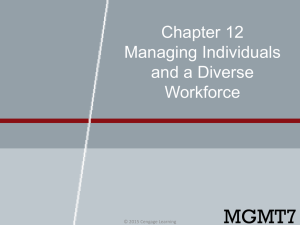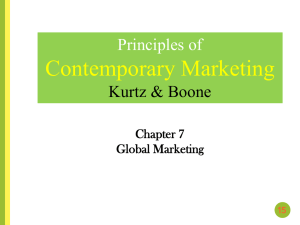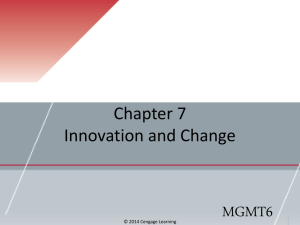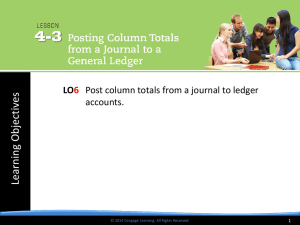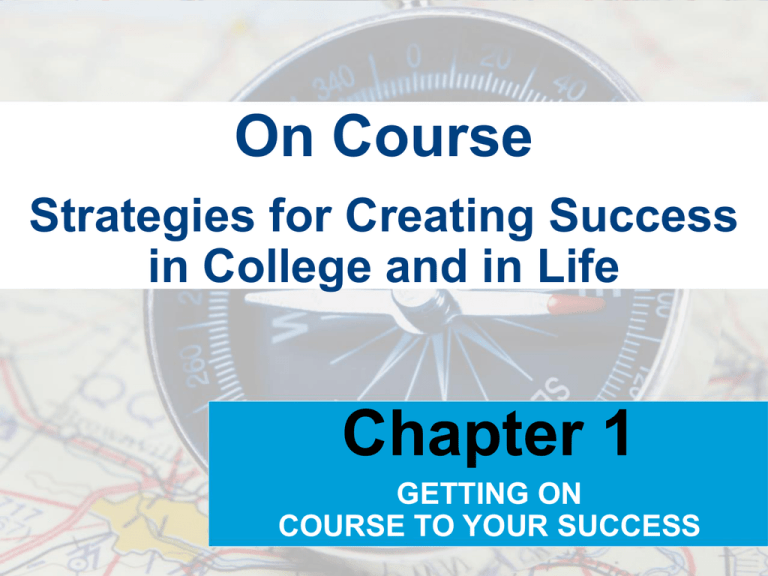
On Course
Strategies for Creating Success
in College and in Life
Chapter 1
GETTING ON
COURSE TO YOUR SUCCESS
TAKING THE FIRST STEP
FOCUS QUESTIONS
What does “success” mean to you?
When you achieve your greatest success…
what will you have,
what will you be doing,
and what kind of person will you be?
Copyright © Cengage Learning. All rights reserved.
1|2
THE POWER OF CHOICE:
THE KEY TO YOUR SUCCESS
Success in college—and, in life—depends
on the quality of the choices we make.
This course is about making wise choices
that promote success as you define it.
Let's take a look at the eight "choices of
successful students."
Copyright © Cengage Learning. All rights reserved.
1|3
CHOICES OF SUCCESSFUL STUDENTS
1.
2.
3.
4.
Copyright © Cengage Learning. All rights reserved.
1|4
CHOICES OF SUCCESSFUL STUDENTS
5.
6.
7.
8.
Copyright © Cengage Learning. All rights reserved.
1|5
Five Suggestions for Creating a Meaningful
ON COURSE JOURNAL
Copy directions.
Be spontaneous.
Be honest.
Be creative.
Dive deep!
Copyright © Cengage Learning. All rights reserved.
1|6
SELF ASSESSMENT: WHY?
What is the purpose of the Self-Assessment?
To assess your strengths and weaknesses in
the eight "choices of successful students."
What is the value of this information?
As you develop the “choices of successful
students,” you make wiser choices and, thus,
achieve more of your desired outcomes and
experiences.
Copyright © Cengage Learning. All rights reserved.
1|7
MAKING YOUR
SELF-ASSESSMENT SCORE VALID
Do NOT try to figure out the "best" response
for each item. The best response is an
honest one!
Remember, the purpose of this selfassessment is to give you an accurate
picture of where you are today on each of
the eight choices.
Copyright © Cengage Learning. All rights reserved.
1|8
SELF-ASSESSMENT:
PREDICTING YOUR SCORES
Before you begin the Self-Assessment…
Review the eight Choices of Successful
Students (see the inside front cover).
On which of these eight choices do you think
you will score highest? Why?
On which of these eight choices do you think
you will score lowest? Why?
Copyright © Cengage Learning. All rights reserved.
1|9
QUICK REVIEW: EIGHT
CHOICES OF SUCCESSFUL STUDENTS
Personal Responsibility
Self-Motivation
Self-Management
Interdependence
Self-Awareness
Lifelong Learning
Emotional Intelligence
Belief in Yourself
Copyright © Cengage Learning. All rights reserved.
1 | 10
ONE STUDENT'S STORY:
Jalayna Onaga
As you read Jalayna's story, what statements
reveal her weaknesses in the Eight Choices? For
example, "And I never asked anyone for help"
shows her weakness when it comes to choosing
Interdependence.
Realizing what she truly wanted for herself allowed
Jalayna to make a strong commitment to being
successful in college. What do you really want and
how will a college education help you achieve it?
Copyright © Cengage Learning. All rights reserved.
1 | 11
BECOMING AN ACTIVE LEARNER
FOCUS QUESTIONS
How does the human brain learn?
How can you use this knowledge to develop
a highly effective system for learning?
Copyright © Cengage Learning. All rights reserved.
1 | 12
THREE PRINCIPLES OF
DEEP AND LASTING LEARNING
Prior Learning: Relate new information to
previously learned information.
Quality of Processing: Use numerous and
varied deep processing strategies.
Quantity of Processing: Use frequent
practice sessions of sufficient length
distributed over time.
Copyright © Cengage Learning. All rights reserved.
1 | 13
QUICK REVIEW
What principle of Deep and Lasting Learning is reflected in
each of these examples?
Remembering what I learned in
my tennis class, I decided to try
using topspin in racquetball.
After each class, I organize my
notes, creating outlines or graphic
organizers to help me remember
the important points.
In math, I do at least fifty practice
problems of each type!
Copyright © Cengage Learning. All rights reserved.
Prior
Learning
Quality of
Processing
Quantity of
Processing
1 | 14
DEEP AND LASTING LEARNING
Following is an anecdote about learning. As
you read it, look for application of the three
Principles of Deep and Lasting Learning:
Prior Learning
Quality of Processing
Quantity of Processing
Copyright © Cengage Learning. All rights reserved.
1 | 15
DEEP AND LASTING LEARNING
One of the most exciting times of my life was the summer I
learned to ride a motorcycle. My friend Dean had a brand
new Honda 50. I'd previously learned how to operate a
clutch and shift gears by driving our tractor on the farm. I
paid eager attention to every detail that Dean told me. I had
him demonstrate each part of the process and then I
practiced each step after he showed me.
It took me a little while to get used to operating the clutch
and throttle with opposite hands and then shifting gears
and using the brake with opposite feet, but I practiced
every day for at least an hour. Within a few weeks, I was
riding around the pasture, having the thrill of my life!! It was
so much more fun than driving an old Ford tractor!
Copyright © Cengage Learning. All rights reserved.
1 | 16
DEEP AND LASTING LEARNING
One of the most exciting times of my life was the summer I
learned to ride a motorcycle. My friend Dean had a brand
new Honda 50. I'd previously learned how to operate a
clutch
and application
shift gears by driving
our tractor
on the farm.
What
of prior
learning
doI
paid eager attention to every detail that Dean told me. I had
youeach
see
story?
him demonstrate
partinofthis
the process
and then I
practiced each step after he showed me.
It took me a little while to get used to operating the clutch
and throttle with opposite hands and then shifting gears
and using the brake with opposite feet, but I practiced
every day for at least an hour. Within a few weeks, I was
riding around the pasture, having the thrill of my life!! It was
so much more fun than driving an old Ford tractor!
Copyright © Cengage Learning. All rights reserved.
1 | 17
DEEP AND LASTING LEARNING
One of the most exciting times of my life was the summer I
learned to ride a motorcycle. My friend Dean had a brand
new Honda 50. I'd previously learned how to operate a
clutch
andapplication
shift gears by driving
our tractor
on the farm. I
What
of quality
processing
paid eager attention to every detail that Dean told me. I had
do you
story?
him demonstrate
eachsee
part ofinthethe
process
and then I
practiced each step after he showed me.
It took me a little while to get used to operating the clutch
and throttle with opposite hands and then shifting gears
and using the brake with opposite feet, but I practiced
every day for at least an hour. Within a few weeks, I was
riding around the pasture, having the thrill of my life!! It was
so much more fun than driving an old Ford tractor!
Copyright © Cengage Learning. All rights reserved.
1 | 18
DEEP AND LASTING LEARNING
One of the most exciting times of my life was the summer I
learned to ride a motorcycle. My friend Dean had a brand
new Honda 50. I'd previously learned how to operate a
clutch What
and shiftapplication
gears by driving of
our quantity
tractor on theof
farm. I
paid eager attention to every detail that Dean told me. I had
processing
dopart
you
see
in the
him
demonstrate each
of the
process
and story?
then I
practiced each step after he showed me.
It took me a little while to get used to operating the clutch
and throttle with opposite hands and then shifting gears
and using the brake with opposite feet, but I practiced
every day for at least an hour. Within a few weeks, I was
riding around the pasture, having the thrill of my life!! It was
so much more fun than driving an old Ford tractor!
Copyright © Cengage Learning. All rights reserved.
1 | 19
BECOMING AN ACTIVE LEARNER
How could you apply the three principles of
deep and lasting learning to a course that
you are now taking? Be specific.
Copyright © Cengage Learning. All rights reserved.
1 | 20
THE CORE LEARNING SYSTEM
Imagine this ambitious goal: You decide to
Take
look at this
littleand
produce
andanother
direct a Broadway
show,
story.
you plan
for it to be a huge hit.
So, you
collect
allhow
of your
and you
You'll
see
youactors,
naturally
get everything
costumes,
applied organized—props,
the four strategies
of
sets, the whole deal.
the Core Learning System.
Now, you start rehearsals and watch very
carefully, evaluating everything—delivery,
blocking, lighting. Then, you realize
something exciting: "This show is going to
be a big hit!"
Copyright © Cengage Learning. All rights reserved.
1 | 21
THE CORE LEARNING SYSTEM
Imagine this ambitious goal: You decide to
produce and direct a Broadway show, and
you plan for it to be a huge hit.
So, you collect all of your actors, and you
get everything organized—props,
costumes, sets, the whole deal.
Now, you start rehearsals and watch very
carefully, evaluating everything—delivery,
blocking, lighting. Then, you realize
something exciting: "This show is going to
be a big hit!"
Copyright © Cengage Learning. All rights reserved.
1 | 22
BECOMING AN EXPERT
1. Divide into Home Groups of four.
2. Each person choose to become the group's expert for
one of the four components of the CORE Learning System:
Collect, Organize, Rehearse, Evaluate.
3. Leave your home group and join others who have
chosen to become an expert on the same CORE
component that you did.
4. Read and discuss with your Expert Group the section in
On Course relating to your CORE component. Your goal is
to be able to teach it to members of your home group.
5. Return to your Home Group, and each expert teach the
others about the CORE component you have been
learning.
Copyright © Cengage Learning. All rights reserved.
1 | 23
JOURNAL REVIEW
This chapter offers five suggestion for
creating a meaningful On Course
journal.
List as many as you can.
The next slide provides the answers…
Copyright © Cengage Learning. All rights reserved.
1 | 24
How many suggestions for creating
a meaningful On Course journal did
you recall?
Copy directions.
Be spontaneous.
Be honest.
Be creative.
Dive deep!
This list is repeated on the
inside back cover of On Course.
Copyright © Cengage Learning. All rights reserved.
1 | 25
ON COURSE PRINCIPLES AT WORK
Identify each of the following as a "Hard Skill"
or "Soft Skill."
Properly mixing epoxy tooth filling material Hard Skill
Identifying bacteria cultures Hard Skill
Working well in teams Soft Skill
Planning work time in order to get everything done
on schedule Soft Skill
Effectively applying tax laws to help a client avoid
an IRS audit Hard Skill
Setting work-related goals Soft Skill
Copyright © Cengage Learning. All rights reserved.
1 | 26
APPLYING THE CONCEPT
A career specialist once said, “Having hard
skills gets you hired; lacking soft skills gets
you fired.”
In your work experience, what evidence
have you seen that supports this statement?
Explain what happened.
Copyright © Cengage Learning. All rights reserved.
1 | 27
BELIEVING IN YOURSELF:
DEVELOP SELF-ACCEPTANCE
FOCUS QUESTIONS
Why is high self-esteem so important to
success?
What can you do to raise your self-esteem?
Copyright © Cengage Learning. All rights reserved.
1 | 28
SELF-ESTEEM
Psychologist Nathaniel Brandon said, “SelfEsteem is the reputation we have with
ourselves.”
How do you think the “reputation we have
with ourselves” is formed?
Copyright © Cengage Learning. All rights reserved.
1 | 29
ONE STUDENT'S STORY:
Phyllis Honore
What did Phyllis need to accept about
herself before she could make positive
choices?
How did that acceptance help her get on
course to her success in college?
Choose one key quotation from Phyllis's
story that provides an insight into being a
success in college and in life. Be prepared
to explain your choice.
Copyright © Cengage Learning. All rights reserved.
1 | 30
WISE CHOICES IN COLLEGE
If you were going to spend a number of
years in a foreign country, what would you
do to prepare for a great experience?
What does this suggest about preparing
yourself for a great experience in the
strange and mysterious country called
"Higher Education?"
Copyright © Cengage Learning. All rights reserved.
1 | 31
REVIEW: THREE PRINCIPLES
OF DEEP AND LASTING LEARNING
Which principle relates new information to
previously learned information?
Prior Learning
Which principle uses numerous and varied
deep processing strategies?
Quality of Processing
Which principle uses frequent practice sessions
of sufficient length distributed over time?
Quantity of Processing
Copyright © Cengage Learning. All rights reserved.
1 | 32
REVIEW: CORE LEARNING SYSTEM
List and define each of the four components
of the CORE Learning System:
• Collect- collect information/skills
• Organize- organize information so that it
makes sense to you
• Rehearse- practice to strengthen neural
networks and improve skills
• Evaluate- assess the effectiveness of
your learning
Copyright © Cengage Learning. All rights reserved.
1 | 33
KEY CHOICES FOR
GETTING ON COURSE TO YOUR SUCCESS
Developing
SelfAcceptance
Becoming
an Active
Learner
Taking the
First Step:
Self Assessment
Copyright © Cengage Learning. All rights reserved.
1 | 34
TICKET OUT
Which of the eight choices of successful
students do you think has the most potential
to help you get on course to achieving your
desired outcomes and experiences? Why?
Copyright © Cengage Learning. All rights reserved.
1 | 35
End
Chapter
One
Copyright © Cengage Learning. All rights reserved.
1 | 36

